Regarding the necessary evils of digital adoption, KPIs (key performance indicators) and metrics are high on the list. While some people love numbers, others prefer to gather experiences from staff to ensure that digital adoption is progressing as it should be, hitting all the right goals. The trick is to align goals with feedback from staff while engaging with staff from a position of support to ensure you achieve ROI for your digital investments.
Gartner’s Q1 2023 IT Spend Forecast suggests that total global IT spending will reach USD 4.5 trillion in 2023. If this prediction is accurate, organizations will need to carry out a considerable amount of digital adoption of new technologies, highlighting the need for a robust system of KPIs and metrics to track goals and success.
To help you measure and track digital adoption with KPIs and metrics, this article will cover the following:
- What are digital adoption KPIs and metrics?
- Measure Digital Adoption In 6 Steps
- Key Digital Adoption KPIs and Metrics to Track In 2023
Let’s begin with a definition of digital adoption metrics and KPIs.
What are Digital Adoption KPIs and Metrics?
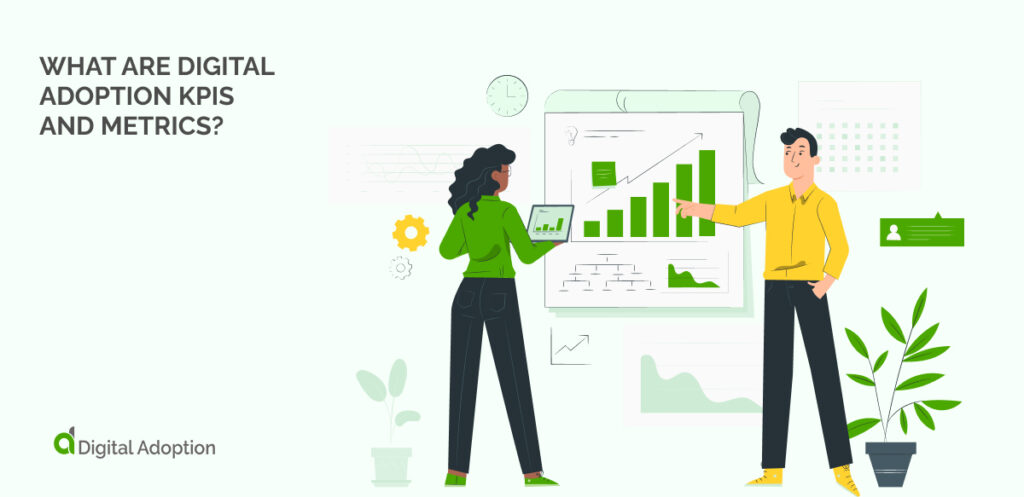
Organizations use digital adoption KPIs and metrics to measure the success and progress of their digital transformation initiatives, which involve the rate at which their staff is learning to use new digital technologies. However, it’s important to note that KPIs and metrics are slightly different.
Digital Adoption KPIs
Companies use digital adoption KPIs as part of their digital transformation efforts using figures formed by measuring how employees successfully engage with their training to use new technologies as part of digital initiatives. For example, ‘the KPI for January indicated that 150 of our 200 employees have adopted new CRM software’.
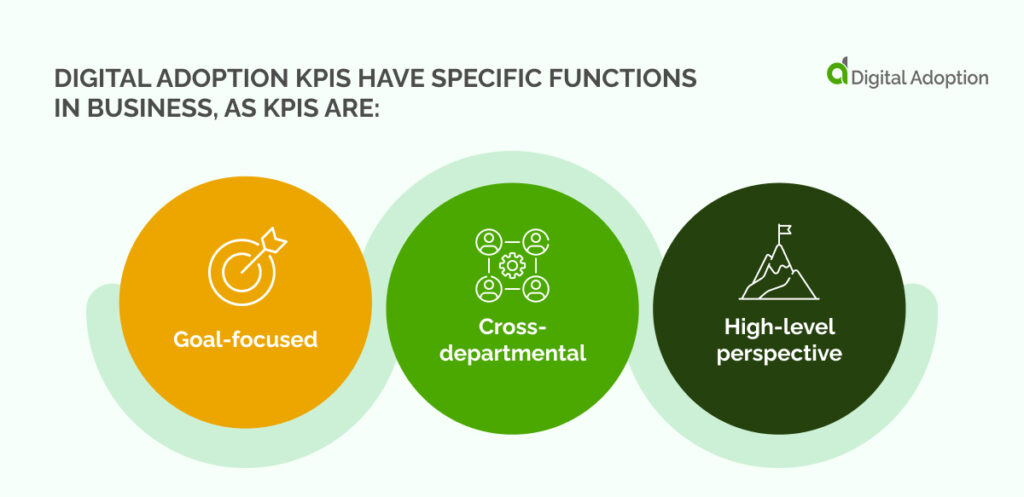
Digital adoption KPIs have specific functions in business, as KPIs are:
- Goal-focused: KPIs represent markers to show that companies have achieved specific goals.
- Cross-departmental: KPIs apply to all departments.
- High-level perspective: KPIs give an organizational view of an initiative’s progress.
If digital adoption KPIs show that staff is not learning to use technologies on schedule, leadership must adjust the digital adoption strategy to increase engagement.
Digital Adoption Metrics
Digital adoption metrics can be confusing as staff can get them easily mixed up with KPIs. Metrics is a broader term, as it simply means any tool used to track digital adoption rates, whether this is experiences or numerical data.
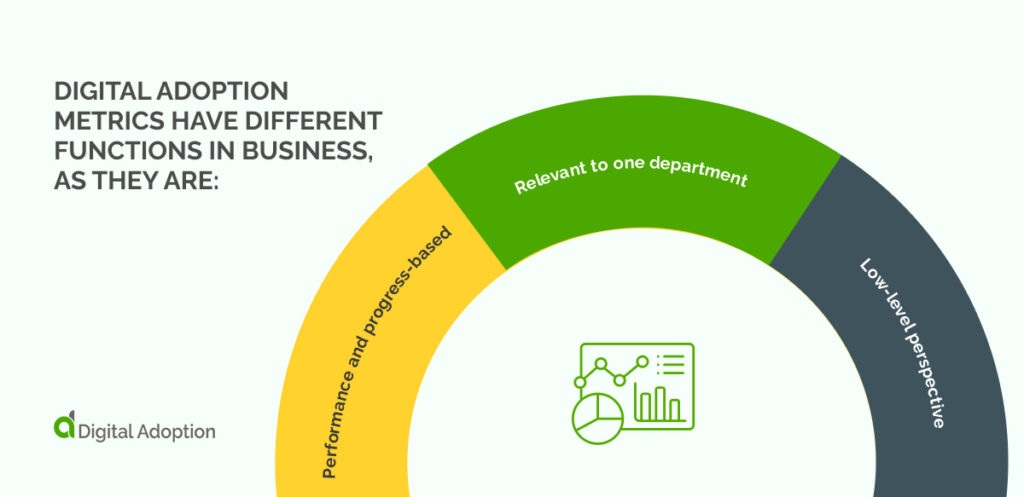
Digital adoption metrics have different functions in business, as they are:
- Performance and progress-based: Metrics measure performance or progress.
- Relevant to one department: Metrics measure aspects of a single department.
- Low-level perspective: Metrics show how a small section of the organization is progressing, for example, a department.
Understanding the differences between KPIs and metrics is essential to ensure you implement the right ones at the right time for digital adoption success.
Now that we have looked at KPIs and metrics let’s look at how to measure digital adoption in six steps.
Measure Digital Adoption in 6 Steps
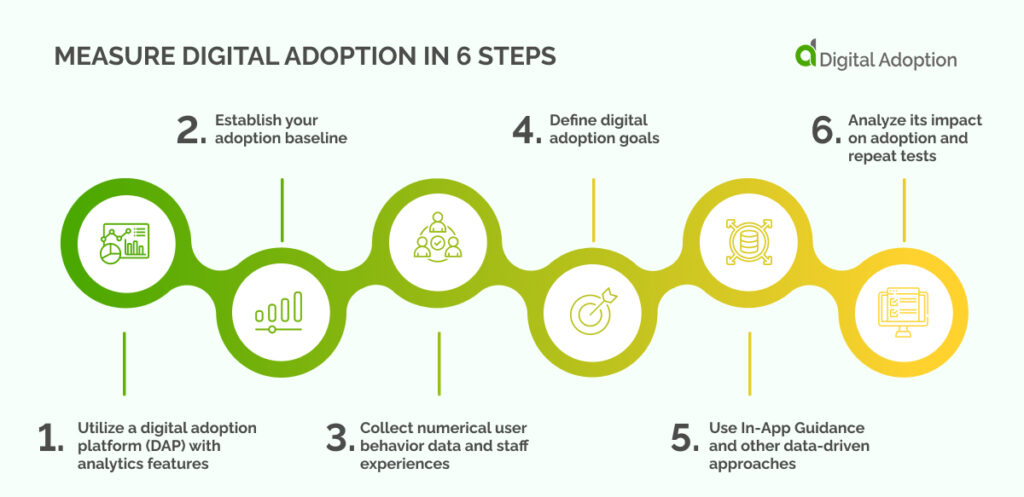
It’s essential to measure digital adoption to achieve digital transformation success. We have presented these six simple steps to measuring digital adoption, beginning with the importance of a DAP.
1. Utilize a digital adoption platform (DAP) with analytics features
If you are trying to improve the way you use existing technologies or learning to use new tools, invest in a Digital Adoption Platform. It is easy to use and can help with onboarding, instructions, tips, and self-help. A DAP could make using technology easier and more enjoyable for everyone.
Digital adoption analytics can help you do training and make support more personalized. You can use groupings of people to increase the number of users in your organization.
2. Establish your adoption baseline
To continue your journey of understanding and to enhance your software utilization, you must first investigate how users engage with the main application programs.
Identify which applications are helpful to your organization, such as customer relationship management (CRM), enterprise resource planning (ERP), or human capital management (HCM). Record the licenses for these tools and integrate your DAP.
With the exceptional analytics of a DAP, you can begin collecting data to understand how your users interact and use these tools. Doing so will provide you with crucial information that allows you to analyze and comprehend the baseline adoption level and create a practical benchmark point to improve.
3. Collect numerical user behavior data and staff experiences
Gather quantitative (number-based) and qualitative (experience-based) data to understand why user adoption levels are low. Qualitative information like employee feedback offers points of view from different roles and end users. It can show what is causing them not to use a platform, what they find helpful, where obstacles may be present, and signal any needs that could help better support usage.
Organizations can collect valuable user feedback within the application by leveraging a DAP. This feedback could be anything from NPS surveys (net promoter score: whether users would recommend a product) to detailed open-form questions about user struggles and in-app guidance.
Combining experience-based data gained through this method with number-based data from your product analytics dashboard provides insight into employee experiences that can help you identify problems impacting adoption rates. Doing so allows you to develop effective strategies for reducing problems and boosting adoption rates.
4. Define digital adoption goals
Once you have evaluated your digital adoption rate and studied the user behavior data and responses, it’s time to create tangible objectives regarding digital adoption that you have based on factual information. You can make decisions more efficiently through these measurable goals for success.
To accurately measure your digital adoption rate, we strongly suggest monitoring several vital indicators:
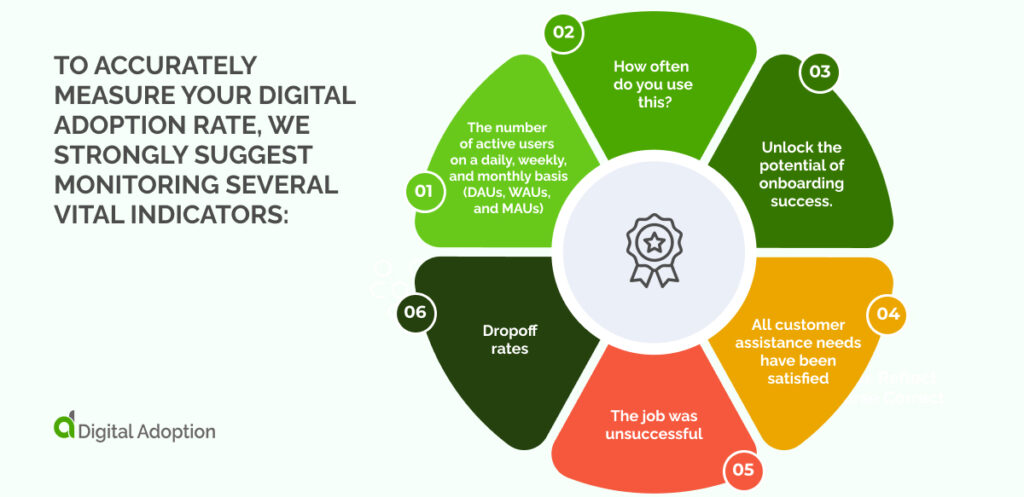
- The number of active users on a daily, weekly, and monthly basis (DAUs, WAUs, and MAUs) can provide insight into the success of your product or service.
- How often do you use this?
- Unlock the potential of onboarding success.
- All customer assistance needs have been satisfied.
- The job was unsuccessful.
- Dropoff rates.
5. Use In-App Guidance and other data-driven approaches
Now that you’ve pinpointed your end users’ requirements and set goals, it’s time to take action. Enhancing accessibility within the app through cutting-edge guidance and help content that assists them as they unlock a product’s full potential is an effective way to do this.
These KPIs all roll into your digital adoption goals, such as:
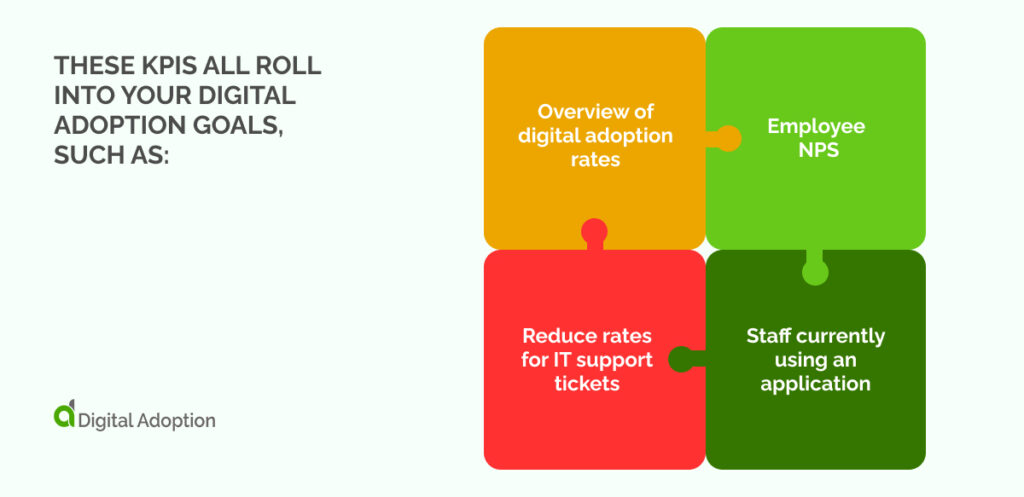
- Overview of digital adoption rates.
- Employee NPS.
- Staff currently using an application.
- Reduce rates for IT support tickets.
6. Analyze its impact on adoption and repeat tests
Your digital adoption journey is an ongoing cycle. As you implement new technologies, processes evolve, and employees require additional support, your flywheel of data collection begins anew. Understanding the success of previous initiatives will allow you to adjust tactics and aim for further improvement with each iteration; analyzing KPIs relative to your business’s adoption journey should be a regular part of this process.
Now that we have examined how to measure digital adoption in six steps let’s look at the key KPIs and metrics to track in 2023.
Key Digital Adoption KPIs and Metrics to Track In 2023
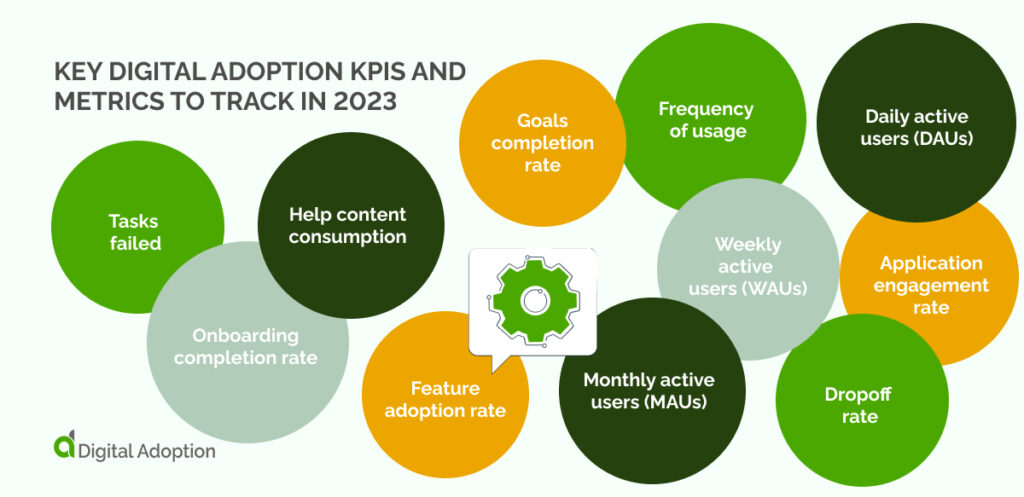
It is helpful to look at examples of KPIs and metrics to track the goals of your digital adoption (KPIs) and your staff’s progress and success rate (metrics). However, always prioritize staff over data; reducing your team to numbers and goals will not supprt the progress of the digital transformation. Staff needs support, training, and motivation for the best employee experience, so focus on these areas instead of a perception of lost revenue or missed ROI.
The first KPI to track in 2023 is the onboarding competition rate.
Onboarding completion rate
Employee onboarding comes at the top of the list when supporting staff to adopt new technologies. Ensure that the onboarding scheme involves experienced staff being present for support and that you personalize onboarding programs to the needs of each staff member.
Tasks failed
Come at the failed tasks metric with a supportive approach, as it may not be the staff member’s fault that they were unsuccessful in completing tasks. Take time to gather feedback from a staff member who has failed to complete a task and offer support based on their feedback.
Help content consumption
Not all of your staff may know how to utilize the help content. The help content consumption metric captures data about who is consuming the help content so you can target extra training for those not using in-app help features.
Application engagement rate
Application engagement rate is one of the most fundamental metrics to track digital transformation progress as it tracks users’ engagement with new digital tools.
Goals completion rate
Despite all digital transformation efforts being about people and their success depending on support, goals are still important. KPIs like the goals competition rate allow you to reinforce the guiding structures that help staff focus on the endpoint vision, maintaining their motivation and direction.
Frequency of usage
Tracking the usage frequency for new applications can help you monitor which new software solutions staff are using. This data allows you to investigate why your team uses some apps more frequently than others and allocate support or change the course of your digital transformation journey accordingly.
Daily active users (DAUs)
The daily active users KPI allows you to monitor how many daily active users you have for your digital assets. This KPI will enable you to see an overview of users on a micro level.
Weekly active users (WAUs)
The weekly active users KPI allows you to monitor how many weekly active users you have for a particular application, giving you a macro view of the user base for each software solution.
Monthly active users (MAUs)
The monthly active users KPI allows you to monitor how many monthly active users you have for a particular application. This KPI gives you a much broader view of users for each month.
Feature adoption rate
The feature adoption rate KPI is significant as it allows you to monitor which features staff use most and find useful for their roles. This KPI is beneficial as it enables you to decide which features to include within SaaS services during the trial period and avoid subscribing to features that are not useful for your organization.
Dropoff rate
The dropoff rate metric measures reductions in the popularity of digital tools. Data acquired by this metric can help you identify where and why certain apps or features are becoming less popular and whether digital transformation adjustments or further training is needed.
Focus on your staff to drive digital adoption metrics and KPI results
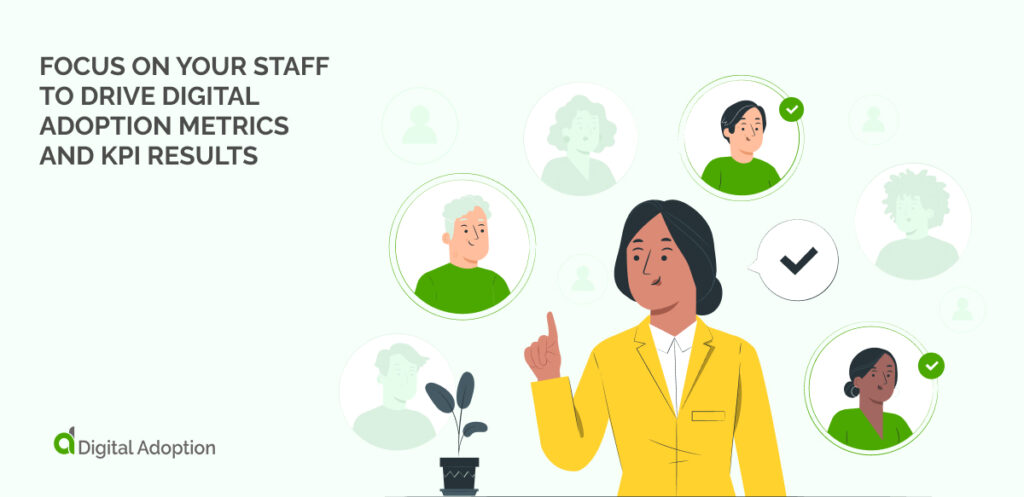
People pilot digital technology, so always use metrics and KPIs to collect data to learn how to support staff rather than simply attempting to measure digital transformation effectively.
Similarly, although digital investments influence revenue, your team drives the ROI of these investments, so you will see the highest return by investing as much of your resources as possible in training, supporting, and listening to the feedback of your team members. When you achieve digital adoption within a successful attempt to measure digital transformation progress, decisions become data-driven, and your company moves toward innovation and growth quickly and consistently.

 FACT CHECKED
FACT CHECKED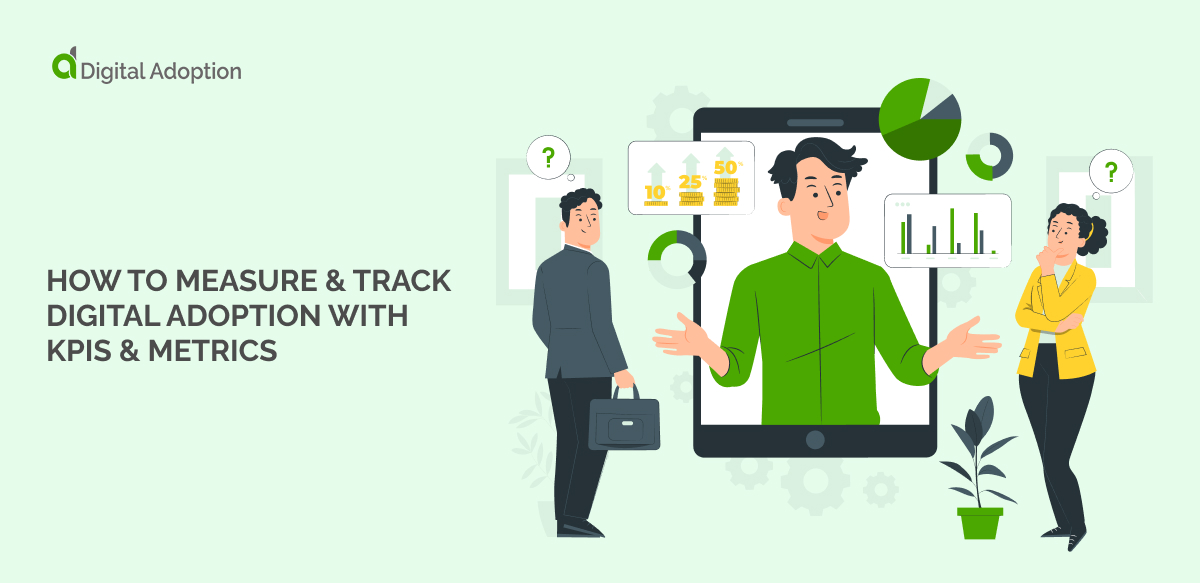



![18 Examples of AI in Finance [2025]](https://www.digital-adoption.com/wp-content/uploads/2025/06/18-Examples-of-AI-in-Finance-2025-300x146.jpg)
![14 Examples of AI in Manufacturing [2025]](https://www.digital-adoption.com/wp-content/uploads/2025/06/14-Examples-of-AI-in-Manufacturing-2025-300x146.jpg)
![29 Examples of AI in Education [2025]](https://www.digital-adoption.com/wp-content/uploads/2025/06/29-Examples-of-AI-in-Education-2025-300x146.jpg)
![15 Examples of AI in Retail [2025]](https://www.digital-adoption.com/wp-content/uploads/2025/06/15-Examples-of-AI-in-Retail-2025-300x146.jpg)


![18 Examples of AI in Finance [2025]](https://www.digital-adoption.com/wp-content/uploads/2025/06/18-Examples-of-AI-in-Finance-2025.jpg)
![14 Examples of AI in Manufacturing [2025]](https://www.digital-adoption.com/wp-content/uploads/2025/06/14-Examples-of-AI-in-Manufacturing-2025.jpg)